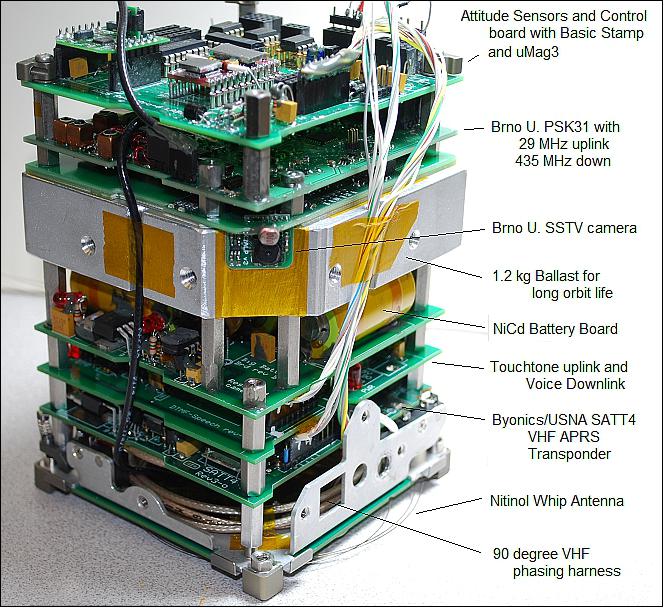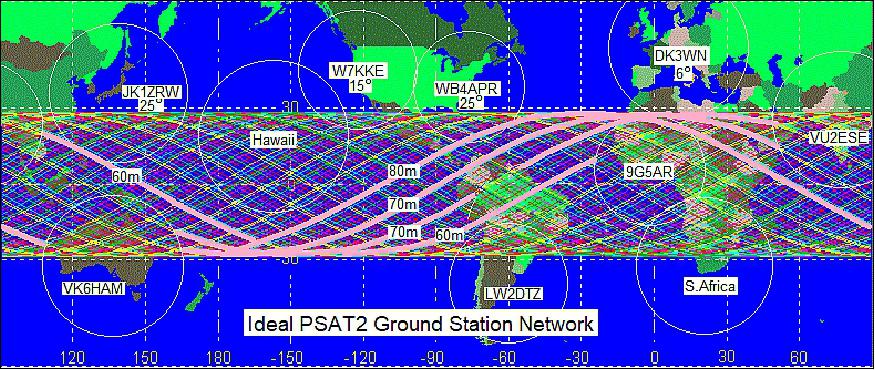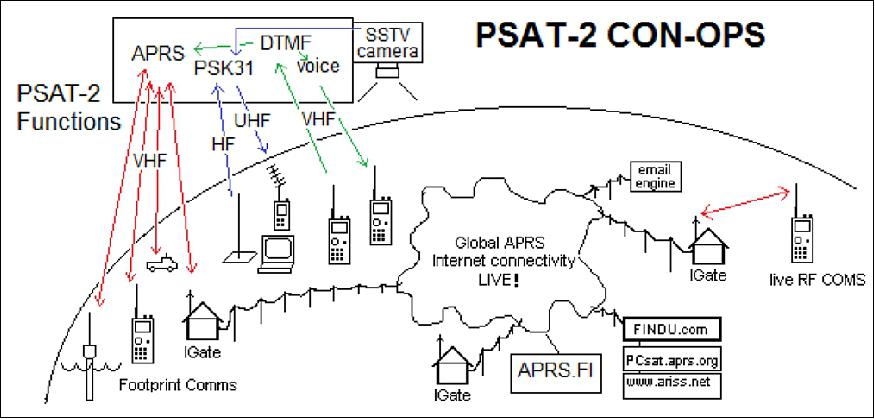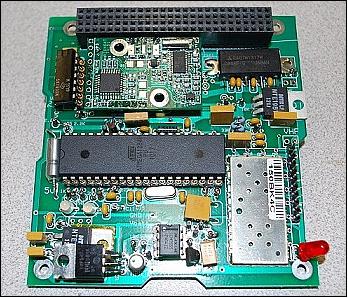PSat-2 (ParkinsonSat-2) CubeSat
Non-EO
USNA (United States Naval Agency)
Quick facts
Overview
| Mission type | Non-EO |
| Agency | USNA (United States Naval Agency) |
| Launch date | 25 Jun 2019 |
PSat-2 (ParkinsonSat-2) CubeSat
Launch PSAT-2 Capabilities References
The PSat- 2 CubeSat of USNA (United States Naval Academy) is a student satellite project, named in honor of Dr. Bradford Parkinson, hailed as the father of GPS. The objective of PSat-2 is to use a two way communications transponder for relaying remote telemetry, sensor and user data from remote environmental experiments or other data sources back to experimenters via a global network of internet linked volunteer ground stations. The data transponder also includes all telemetry, command and control for a complete CubeSat. 1)

PSAT-2 is a student senior engineering project built by a group of students at the Naval Academy for self training in smallsat technology. It is scheduled to fly on an STP-2 launch opportunity with a life span of several years. It continues the PCsat (2001) and PSAT-1 (2015) missions containing an APRS (Automatic Packet Reporting System) packet radio communications transponder for relaying remote telemetry, sensor and user data from remote users and amateur radio environmental experiments or other data sources back to Amateur Radio experimenters via a global network of internet linked volunteer ground stations. The APRS transponder also includes telemetry, and some command and control for the user modes. PSAT-2 also adds a unique experimental DTMF (Dual-Tone Multi-Frequency) uplink on 145.98 MHz for users in the field who might not have access to an APRS radio.

PSAT-2 was delivered in April 2019 to Cal Poly and integrated with BRICSAT into its P-Pod (#4) for launch on a SpaceX Heavy into a 28 deg elliptical orbit.
Launch
PSAT-2 is a secondary payload on the STP-2 rideshare mission of USAF, launched on 25 June 2019 (06:30 UTC) aboard a SpaceX Falcon Heavy launch vehicle from Launch Complex 39A at NASA's Kennedy Space Center. The STP-2 payload includes six FormoSat-7/COSMIC-2 satellites (primary payload, each with a mass of 280 kg), developed by NOAA and Taiwan's National Space Organization to collect GPS radio occultation data for weather forecasting. The mission also carries several NASA technology demonstrations. The STP-2 mission is led by the Air Force Space Command's Space and Missile Systems Center (SMC). The total IPS (Integrated Payload Stack) has a mass of 3700 kg. 2)
Secondary Payloads
• DSX (Demonstration and Science Experiments) mission of AFRL. The payload consists of four small technology demonstrations (600 kg) to study how spacecraft electronics respond to space radiation. DSX is to be delivered into MEO (6-12,000 km altitude).
• GPIM (Green Propellant Infusion Mission), a demonstration minisatellite of NASA (~180 kg). 3)
• FalconSat-7, a 3U CubeSat mission developed by the Cadets of the U.S. Air Force Academy (USAFA) at Colorado Springs, CO.
• NPSat-1 (Naval Postgraduate School Satellite-1) of the Naval Postgraduate School, Monterey, CA. A microsatellite of 86 kg.
• OCULUS-ASR (OCULUS-Attitude and Shape Recognition), a microsatellite (70 kg) of MTU (Michigan Technological University), Houghton, MI, USA.
• Prox-1, a microsatellite (71 kg) of SSDL (Space Systems Design Laboratory) at Georgia Tech.
• LightSail-2 of the Planetary Society, a nanosatellite (3U CubeSat, 5 kg) will be deployed from the parent satellite Prox-1.
• ARMADILLO of UTA (University of Texas at Austin), a nanosatellite (3U CubeSat) of ~ 4 kg.
• E-TBEx (Enhanced Tandem Beacon Experiment), a tandem pair (3U CubeSats) of NASA and SRI International.
• TEPCE (Tether Electrodynamics Propulsion CubeSat Experiment), a 3U CubeSat (3 kg) of NPS (Naval Postgraduate School).
• CP-9 , a joint CP-9/StangSat experiment, which is a collaboration between PolySat at Cal Poly and the Merritt Island High School, and is sponsored by the NASA LSP (Launch Services Program). CP-9 is a 2U CubeSat while StangSat is a 1U CubeSat.
• PSat-2 (ParkinsonSat-2), a student built 1.5U CubeSat of USNA (US Naval Academy) with a mass of 2 kg. Relay radio data from remote sensors to ground station and serve ham radio users.
• BRICSAT-2, a student built 1.5U CubeSat of USNA (US Naval Academy) to demonstrate a µCAT electric propulsion system and carry a ham radio payload.
• OTB-1 (Orbital Test Bed-1) a minisatellite of SSTL (based on the SSTL-150 bus, 138 kg). One of the hosted payloads is NASA's DSAC (Deep Space Atomic Clock), a technology demonstration mission with the goal to validate a miniaturized, ultra-precise mercury-ion atomic clock that is 100 times more stable than today's best navigation clocks.
• Ballast: Required in original mission contract to be delivered into MEO (6-12,000 km altitude); mass (< 5000 kg) and composition currently unknown.

Orbits
The STP-2 mission will be among the most challenging launches in SpaceX history with four separate upper-stage engine burns, three separate deployment orbits, a final propulsive passivation maneuver and a total mission duration of over six hours. It will demonstrate the capabilities of the Falcon Heavy launch vehicle and provide critical data supporting certification for future National Security Space Launch (NSSL) missions. In addition, [the USAF] will use this mission as a pathfinder for the [military's systematic utilization of flight-proven] launch vehicle boosters.
The three orbits of the STP-2 mission for spacecraft deployment are:
1) The small secondary CubeSat satellites will be deployed into an elliptical orbit of ~300 x 860 km, inclination of ~28º. These are: OCULUS-ASR, TEPCE, E-TBEx, FalconSat-7, ARMADILLO, PSAT-2, BRICSAT, and CP-9/StangSat.
2) The second deployment batch of the STP-2 mission will occur at a circular altitude of 720 km and an inclination of 24º.
- Deployment of LightSail-2, Prox-1, and NPSat-1
- Deployment of OTB-1 with NASA's DSAC and GPIM
- The six FormoSat-7/COSMIC-2 satellites will be deployed into the initial circular parking orbit of 720 km. Eventually, they will be positioned in a low inclination orbit at a nominal altitude of ~520-550 km with an inclination of 24º (using their propulsion system). Through constellation deployment, they will be placed into 6 orbital planes with 60º separation.
3) The third and final deployment will be the Air Force Research Lab's DSX spacecraft as well as the ballast, which will be delivered to an elliptical MEO (Medium Earth Orbit) with a perigee of 6000 km and an apogee of 12000 km, inclination of 43º.

Capabilities Summary
PSAT-2 contains multiple transponder functions which will be used in the following descending priorities as power permits. The concept of operations is to give PSK31, a guest payload from Brno University, priority. But DTMF and Voice are also an exciting new APRS capability too. Conventional APRS digipeating is of low priority and will usually be off to minimize channel congestion. 4)

Operating Modes: PSAT2 consists of a number of exciting and unique Amateur Communications transponders as listed here:
• First is a newer PSK31 29 MHz uplink/UHF FM downlink from Brno University following on to the original on PSAT
• Second is a Brno SSTV camera that downlinks in the same UHF FM waterfall as the PSK31 users
• Third is a DTMF Grid Square uplink and Voice/APRS downlink for Grid position reporting
• Forth is DTMF Text messaging (APRStt).
• Fifth is APRS text messages up and Voice down.
• Sixth is a conventional APRS digipeater that will join a number of sister APRS Amateur Satellite transponders.
• Plus, almost HALF the satellite's mass is in a huge lead ballast to nearly double the orbit life and ham radio access.
Low Cost Comms Board: Another feature of this CubeSat is our development of a standardized cubesat communications card (shown below right) based on the popular Byonics MTT4B all-in-one APRS Tiny-Track4 module. We are standardizing the MTT4B onto a standard cubesat-104 board (and adding a 9600 baud UHF downlink if needed) to allow other schools to rapidly develop their own amateur radio cubesat projects. We call this board the SATT4.

Operations under ITU Rules: PSAT2 will operate under the ITU rules of the Amateur Satellite Service. See how PSAT-2 design and operation fit entirely within the ITU International Amateur Radio RULES. The FCC does not issue licenses for Amateur Radio Spacecraft (see public notice) because they are operated under the license of the individual amateur radio operator who is responsible to assure that both the design and operation are within the rules of the ITU as interpreted by the IARU (International Amateur Radio Union). Our licensed control operator is Todd Bruner, WB1HAI in Annapolis.
APRS Up/Downlink. 145.825 1200 baud APRS (shared with ISS, PCSAT, PSAT, AISAT-1 and others!)
DTMF Uplink . . . . . . 145.980 MHz (Voice confirmation down on 145.825 MHz)
PSK31 Downlink. . . . 435.350 MHz +/- 5 kHz FM (300 mw)
PSK31 Uplink . . . . . . 28.120 MHz +2 kHz PSK31 SSB (25 watts into omni vertical authorized)
PSAT2 Digipeater Aliases: To join the existing APRS satellites on orbit and operate as a seamless constellation, PSAT-2 supports the same APRSAT and ARISS generic aliases as the original PCSAT (NO44) PSAT and the packet system on the ISS so that users do not have to change any parameters when using any of these three APRS transponders.
References
1) Bob Bruninga et al., "PSAT2 - Amateur Radio Communications Transponders USNA Student Satellite Project 2014-2019!," URL: http://aprs.org/psat2.html
2) Stephen Clark, "Falcon Heavy launches on military-led rideshare mission, boat catches fairing," Spaceflight Now, 25 June 2019, URL: https://spaceflightnow.com/2019/06/25
/falcon-heavy-launches-on-military-led-rideshare-mission-boat-catches-fairing/
3) "GPIM Spacecraft to Validate Use of 'Green' Propellant," NASA, Aug. 19, 2014, URL:
http://www.nasa.gov/content/gpim-spacecraft-to-validate-use-of-green-propellant/
4) "PSAT-2 User Operations Manual," USNA, 13 June 2019, URL:
http://aprs.org/PSAT2/USER-Operations-Manual.doc
The information compiled and edited in this article was provided by Herbert J. Kramer from his documentation of: "Observation of the Earth and Its Environment: Survey of Missions and Sensors" (Springer Verlag) as well as many other sources after the publication of the 4th edition in 2002. - Comments and corrections to this article are always welcome for further updates (eoportal@symbios.space).